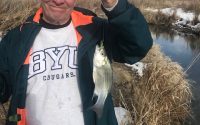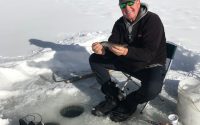Improve Your “Blade” Techniques
By Don Allphin
April 07, 2005
For more than 30 years, spinnerbaits have maintained their popularity with bass anglers though over the years, hundreds of competing lures have entered the market, from life-like soft plastics to expensive foreign-made hard baits. Through it all, the simple, inexpensive, and straight-forward spinnerbait has not only weathered the competitive storms it remains a standard in most anglers’ tackle boxes. Whether they are among your favorite go-to baits or are reserved for special situations only, a few pointers from the pros should improve your confidence in this long-lived and versatile bait.
Spinnerbaits, for a variety of reasons have been cubby-holed by some amateur anglers to be used only within a narrow range of conditions. When the wind blows, during periods of low light, or in stained or dirty water are really the only times many anglers turn to “blades.” But over the past five years I have interviewed the majority of the world’s top professionals, and to a man, they believe that to cubby-hole a spinnerbait is very short-sighted. Though each professional might reach for a spinnerbait at different times, they all respect and admire it as a great fish-catching tool. Let’s look at several of the pros’ best spinnerbait techniques.
Fish Shallow and Wear Sunglasses
“Even before I throw my first spinnerbait,” says Kevin VanDam, former Bassmaster Classic champion and a truly gifted bass professional, “I put on a good pair of polarized glasses. It’s crucial to be able to see the structures I’m trying to fish, an underwater rock, or clump of grass, or a light spot on the bottom — polarized sunglasses allow me to see more targets.” Rick Clunn agrees with VanDam but says it in a different way.
“I actually see the bass strike my spinnerbait around 70 percent of the time,” Clunn says. “That’s why I believe it’s so important to watch the lure throughout the entire cast.” His comment provides a hint as to how deep Rick likes to run his spinnerbaits. Even in clear water, visibility is generally limited to between five and 10 feet, so for the most part, spinnerbaits should be fished quite shallow.
One of the few exceptions to that general statement comes from B.A.S.S. professional Stacey King who explains: “There are times when the water is really hot and the fish are really deep, that I will throw a very heavy (one ounce or larger) spinnerbait. I will throw the bait as far as I can and let it helicopter to the bottom. Then I’ll slow-roll the bait back in. I’ve had bites in 30 feet of water in the dead of summer with this presentation.”
Keep Your Spinnerbait in the Strike Zone
One of the things I notice each time I’m in the boat with a professional angler is how far they cast and how long during the day their baits are wet. In other words, a professional knows that dry baits can’t be good when trying to catch bass. This same principle applies to fishing spinnerbaits.
“You’ve got to try to keep your spinnerbait in the strike zone for as long as possible,” says Scott Nielsen, long-time Ranger boats professional. “When possible try and keep your spinnerbait at the same depth for the duration of the cast.” Nielsen is one of the best shallow-water anglers in the West, and believes in giving the bass every possible opportunity to take the bait. Kevin VanDam explains the same principle in a slightly different way but with similar results.
“I position my boat so that I can cast parallel to the bank or structure that I’m fishing,” he says. “Whether it’s a grass line, a sand bank or even a line of trees, I try to keep that bait in front of the fish for as long as possible. If you fish on an angle to the bank, some might say ‘quarter’ towards the bank you will be able to keep the lure squarely in the strike zone for the majority of each cast.”
Always Use a Trailer Hook
“I will not throw a spinnerbait without a trailer hook in place,” continues VanDam. “Too often a fish will strike at the bait without actually taking it completely into its mouth, but with a trailer hook I have a better opportunity to hook more fish.”
There are several schools of thought in regards to trailer hooks. Some pros invert the hook so it rides in the opposite direction as the primary spinnerbait hook, while others opt to have the trailer hook mirror the primary hook. Some professionals use a smaller rather than larger trailer hook, and yet others demand a larger hook than even the primary hook. On average, those I interviewed prefer a 2/0 or 3/0 hook as their trailer hook.
Another school of thought is centered on whether or not to keep the trailer hook stationary. When choosing a trailer hook most pros I interview turn to a hook with and enlarged eye so that it easily fits over the point of the primary hook. Then they either place a rubber or plastic “stopper” on the primary hook behind the barb so that the trailer hook can’t come off during a cast, or they thread a piece of rubber or plastic tubing onto the primary hook and then secure the trailer hook firmly to the tubing so that the trailer hook cannot move around freely on the shank of the primary hook. Scott Nielsen is quite adamant as to which hooks he uses and how he likes to rig his trailer.
“I prefer a Gamakatsu trailer hook,” says Nielsen. “They make a good, sharp hook, and with a keeper in place the hook will ride freely on the shank and look just as it should – as an extension of the main hook.”
View Structure as Your Friend
Most anglers that use spinnerbaits try to come close to structure: next to a rock or limb, close to a dock or ledge, etc. But the pros I fish with take “close to structure” to an entirely new dimension.
“I don’t think I’ve made a good retrieve unless I’ve smacked a piece of structure on my way back to the boat,” says Kevin VanDam. “It seems that when a spinnerbait hits structure, the bass think it’s a weak or hurt baitfish and are excited by the bump. And that’s exactly what I want – a bass to react to the spinnerbait.”
In Western lakes such as Lake Powell and Lake Mead, the structures might be different than they are in other parts of the country, but the results are the same. “At times I’ll throw my spinnerbait right in the middle of a bunch of tumbleweeds,” says Scott Nielsen. “Or I might purposely allow the spinnerbait to hit a rock wall and slide down the side and into the water. Fish responds to the noise created when baits suddenly stop or move out of position.”
If you’re still not sure when or how to throw a spinnerbait, do what I did a few years ago: for a couple of weeks don’t even put another lure in your boat. If a spinnerbait is the only lure you’re able to fish, it’s amazing how quickly you’ll be sold on (as the pros are) the many, many uses of this incredible, yet simple bait.











